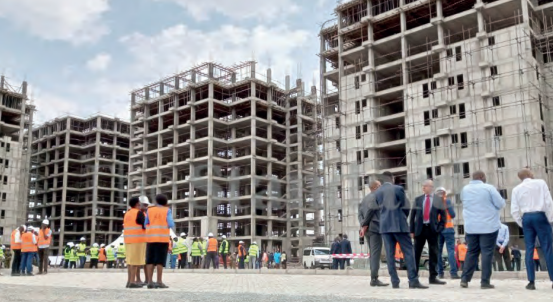
Property prices stagnated in the
third quarter of 2024 (July - September), according to the latest market
report, with land prices in Nairobi’s
suburbs marginally growing by 1.6
per cent.
This is on the back of economic uncertainty and the recent civic unrest, real estate fi rm –HassConsult said in its quarterly indices released on Tuesday, which also saw rental prices fall.
Sale prices across property in Nairobi’s suburbs and satellite towns grew by 0.7 percent, compared to a 1.0 per cent growth in quarter two, while asking rental prices contracted by 0.6 per cent, having been flat in the previous period.
During the period, land prices in Nairobi’s suburbs rose by 1.6 per cent, marginally lower compared to the second quarter growth of 1.8 per cent.
Protests that hit the country in June and July saw cautious pricing in a period of uncertainty, the firm noted, dampening the market that was coming off a period of strong price growth in the last quarter of 2023 and fi rst half of 2024.
“The property rental market eased after a strong period of growth between October 2023 and June 2024, when monthly rental price growth averaged at three per cent. The market aligned with prevailing tough economic conditions, characterized by protests in June and July,” HassConsult head of development consulting and research, Sakina Hassanali, said.
Sales prices for all property in the Nairobi suburbs remained unchanged at -0.9 per cent in the quarter, while satellite towns witnessed a decline of 0.2 per cent, compared to a growth of 2.1 per cent in the second quarter.
Suburbs that recorded drops in property prices, albeit marginal, include Gigiri, Kilimani, Kitisuru and Runda. Ridgeways, Loresho, Muthaiga and Westlands however recorded slight increases.
Apartments in both city suburbs and satellite towns lagged behind standalone units in price appreciation. Seven out of nine suburbs with apartments – Kileleshwa, Kilimani, Lavington, Muthangari, Upperhill and Westlands reported negative price movement, as did six out of nine satellite towns including Athi River, Ngong, Kitengela and Ruiru.
Apartments account for the bulk of available units for sale ( 67.7 per cent) and letting ( 62.8 per cent) in Nairobi.
“The apartment segment saw some price correction in the period due to increased supply of units, which now account for two thirds of all property available for sale in the market,” said Hassanali.
The price-performance at the end of the quarter reflected the general slowdown in the real estate sector coming into the quarter.
Official government data shows that the construction sector GDP contracted by 2.9 per cent in quarter two of 2024, compared to a growth of 2.7 per cent in the corresponding period in 2023.
With the reduction in inflation and expected fall in interest rates however, both the rental and sales segments are looking at prospects of recovery in the coming months as consumer purchasing power improves.
Positive price movement however showed overall resilience of land as an asset in a period of economic difficulties, characterised by high interest rates and uncertain political environment.
Rising land demand for new developments supported the price growth, as the real estate sector continued its recovery from a prolonged slump.
In the city’s suburbs, land prices have now gone up by more than one percent, in each of the last four quarters, breaking the prior run of 26 straight periods of sub-one percent growth.
Parklands, which has had a surge of development activity – for both commercial and residential developments in the last two years, led the market with land price increases of 3.4 per cent to average Sh434.2 million per acre.
Upper Hill however remained the
most expensive place to buy land
with an acre going for an average
Sh506 million, followed by Westlands (Sh479.6 million), Parklands
(Sh434.2 million), Kilimani Sh406.1
million) with Muthaiga closing the
top five costly areas with an average
land asking price of Sh383.2 million
per acre.

 © The Star 2024. All rights reserved
© The Star 2024. All rights reserved